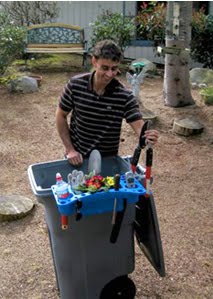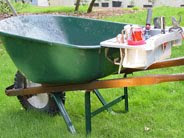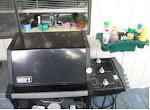Use this list to help you figure out what gardening tasks you want to accomplish in the month of May. Plan now so you'll be ready!
 |
| photo by the GTC Garden Guy |
Planting
- Plant seed or seedlings of warm-season crops like tomatoes, peas, beans, sweet corn, cucumbers, eggplants, melons, peppers, pumpkins, and summer squash.
- Sow beets, carrots, lettuce, and radishes
- Plant herbs such as thyme, sage, parsley, chives and basil
- Plant spring flowering shrubs like rhododendrons, azaleas, and camellias
- Plant or sow summer annuals such as geraniums, marigolds, lobelia, impatiens, sunflowers, zinnias, cosmos, alyssum, and phlox
Important Transplant Info
Transplants become less stressed when they are set out on a cloudy, calm day. Unfortunately, gardeners may need to transplant when they have the time, regardless of the weather. Strong sun and wind are hard on new transplants, so set out plants in the late afternoon when the wind comes down and the plants have overnight to acclimate. Provide shade and wind protection with berry baskets, small crates, or screens. Mulching helps since it lowers the rate at which water evaporates from the soil and controls the soil temperature. For a complete tutorial on How To Use Mulch Properly, and The Wonders of Mulch, see www.weekendgardener.net/garden-plants/mulch-060806.htm
Maintenanace
- Feed roses after their first bloom, then repeat feeding every four to six weeks. Try a complete fertilizer like a 10-10-10 granular or liquid soluble
- Fertilize everything right now. Annuals, fruit trees, fuchsias, perennials, shrubs, etc. Use a higher phosphorous fertilizer like a 10-60-10 for better flower, fruit, and vegetable set
- Feed spring-flowering shrubs like azaleas, camellias, and rhododendrons with an acid based fertilizer as soon as they have finished flowering
- Later in the month, thin fruit on heavily bearing trees. With triples and doubles, prune to singles
- To revitalize and encourage branching remove spent flowers from camellias, roses, azaleas, fuchsias, geraniums , rhododendrons, impatiens, and all annuals. This will lengthen the flowering time for eachplant and keep it shaped and compact
- Newly planted trees and shrubs should be watered deeply every week or two until fall rains begin
- Water established trees and shrubs deeply and infrequently to help with-stand summer heat
- Mulch soil to save water, smother weeds, keep soil cooler. Spread 1-3 inches (2.5-7cm) of bark chips, compost, wood shavings, or other organic material under shrubs trees, annuals and vegetables.
- Prune spring-flowering shrubs and vines after bloom.
- Prune rhododendrons immediately after flowering. Old clusters should be snapped off when partly dry, but remove with care in order not to decrease or prevent bloom next year.
- Divide indoor plants when new growth starts in spring. Root cuttings during spring and summer when the plant is actively growing.
Letting a young lawn grow too tall and then cutting it back to the recommended height is detrimental.
Such extreme leaf removal stops the flow of food to the roots, weakens the plants, and opens the lawn to diseases. Never let it grow so tall that you have to cut off more than one third of the grass blade.
More Tips:
- To keep garden plants growing at a steady rate, fertilize them with manure tea or diluted fish emulsion every six weeks.
- Lightly side dress perennials, including spring bulbs, with a 5-10-10 or 10-10-10 fertilizer, being careful to avoid the center or crown of the plant.
- Caladiums need generous amounts of water and fertilizer to encourage continuous production of new leaves during the summer. Apply a light, side dressing of 5-10-5 fertilizer every two weeks, and water thoroughly to encourage bright-colored foliage.
- Pinch back annuals when 4 to 6 inches (10 to 15 cm) high to promote bushy growth. Some that require pinching are zinnias, petunias, and salvia.
Weed and Pest Control
- Keep an eye out for aphids and earwigs and get them before they take over your plants.
- Aphids? Spray infested stems, leaves, and buds with very dilute soapy water, then clear water. It works on even the heaviest infestation.
- Where earwigs and sowbugs (slaters) are a problem, try trapping them with rolled up newspapers moistened with water. The insects will hide in the papers by day. Gather up the traps and dispose of them frequently.
Introducing your children to gardening can be a rewarding experience for the entire family. Give them a small plot of their own with full sun, good soil, and drainage. Geraniums and begonias from pots are easy for little hands to handle, and marigolds, radishes, and favorite vegetables can be added. It's a pleasant
and productive way to spend time together.
- Keep It All Together in the Garden!
_____________________________________
Thank you to http://www.weekendgardener.net/index.html Please visit their site for some more great info.
______________________________________
Good to know:
Garden & Tool Caddy was created by a true garden lover who “donated” one too many garden tools into his recycling bin, whose dog knocked over his water bottle ten too many times, and whose cell phone is still “out there” somewhere under a bush. Please check out our first post to see how we got started: http://gardenloversdelight.blogspot.com/2009/10/new-treat-for-gradener.html You'll see lots of fun pictures, too!
_____________________________________________________





+(Small).jpg)






.jpg)


.jpg)

1 comment:
Very helpful.
Post a Comment